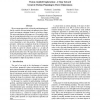Free Online Productivity Tools
i2Speak
i2Symbol
i2OCR
iTex2Img
iWeb2Print
iWeb2Shot
i2Type
iPdf2Split
iPdf2Merge
i2Bopomofo
i2Arabic
i2Style
i2Image
i2PDF
iLatex2Rtf
Sci2ools
ICRA
1993
IEEE
1993
IEEE
Vision-Guided Exploration: A Step Toward General Motion Planning in Three Dimensions
We present an approach for solving the path planning problem for a mobile robot operating in an unknown, three dimensional environment containing obstacles of arbitrary shape. The main contributions of this paper are (1) an analysis of the type of sensing information that is necessary and sufficient for solving the path planning problem in such environments, and (2) the development of a framework for designing a provablycorrect algorithm to solve this problem. Working from first principles, without any assumptions about the environment of the robot or its sensing capabilities, our analysis shows that the ability to explore the obstacle surfaces (i.e., to make all their points visible) is intrinsically linked with the ability to plan the motion ofthe robot. We argue that current approaches to the path planning problem with incomplete informationsimply do not extend to the general three-dimensional case, and that qualitatively different algorithms are needed.
| Added | 08 Aug 2010 |
| Updated | 08 Aug 2010 |
| Type | Conference |
| Year | 1993 |
| Where | ICRA |
| Authors | Kiriakos N. Kutulakos, Vladimir J. Lumelsky, Charles R. Dyer |
Comments (0)

